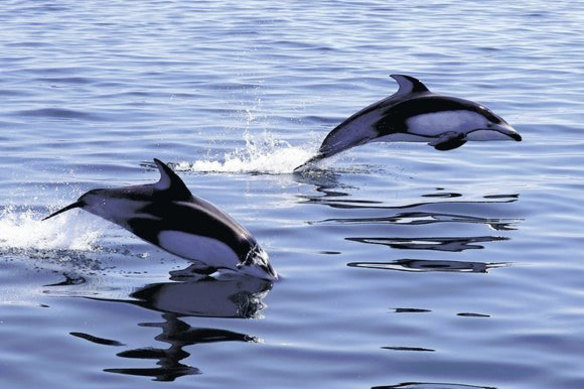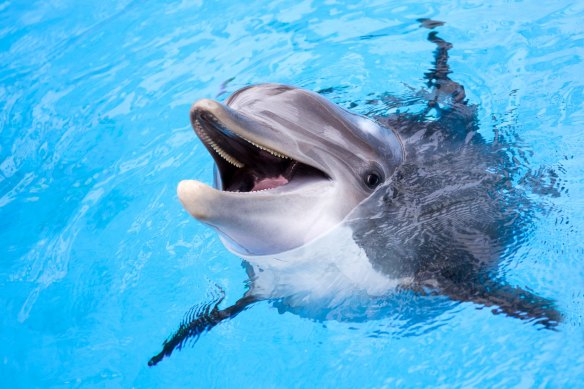By Hisako Ueno and Yan Zhuang
At the beaches along an idyllic coastal stretch of central Japan, lifeguards scan the water, poised to call swimmers back to shore at the hint of a fin. Sharp teeth bare from posters warning beachgoers to be careful because, for the third year running, there is danger in the water.
No, it’s not sharks. It’s dolphins. Possibly just a single lonely, sexually frustrated dolphin.

Pacific white-sided dolphins jump around a sightseeing boat in Japan’s Mutsu Bay.Credit: Japan News-Yomiuri
In Wakasa Bay, about 300 kilometres west of Tokyo, dolphin attacks have injured at least 47 people since 2022. Many of them suffered minor bites on their hands, but a few were rushed to hospitals with broken bones or wounds that needed stitches.
In 2022, 21 people reported injuries from dolphin attacks along a stretch of beaches near the town of Echizen, according to police in Fukui prefecture. Most were reported in what one Japanese media outlet called the “dolphin threat summer”.
One man told local media that he was swimming close to the shore when a dolphin bit his arm and tried to force itself on top of him, almost pushing him underwater.
The next year, the attacks were concentrated on beaches down the coast near the town of Mihama. In 2023, 10 people were injured, a Fukui police spokesperson said. In one case, a man was left with broken ribs.

Dangerous, not cute: Dolphins.
Since July 21 this year, 16 people have been injured in dolphin attacks, mainly off the beaches near Mihama and nearby Tsuruga city, according to local officials. Two of them had serious hand injuries that needed dozens of stitches.
Why have the dolphins come so close to the shore? Are they being aggressive or just playful? Why have these attacks continued for so long?
“Who knows the reason? We have to ask the dolphins,” said Hiromu Nohara, a Mihama town official.
There are some theories, though.
For one, it may be a single dolphin. Ryoichi Matsubara, the director of Echizen Matsushima Aquarium in Fukui, said the photos and videos he reviewed of some of the 2022 and 2023 attacks appeared to show the same male Indo-Pacific bottlenose dolphin.
Matsubara said the same dolphin might also have been responsible for this year’s attacks, although he had not yet obtained recent footage.
The dolphin might be acting out mating behaviour, he said, adding that in 2022 and 2023, it was observed trying “to press his genitals against people”. But in many cases, beachgoers were bitten when they approached or attempted to touch the dolphin, Matsubara said.
Putu Mustika, a lecturer and marine researcher at James Cook University in Australia, said dolphins can inadvertently harm humans when acting out mating behaviours because of their sheer strength.
“Dolphins, when they are mating, can be very wild,” she said, adding that lunging on top of a human could be a sexual act and a sign that this was a “horny, lonely dolphin”.
This dolphin could also be naturally aggressive and aggravated by humans trying to touch it, Mustika added.
Dolphins are usually social pack animals, but solitary dolphins who seek human contact are not uncommon.
In the 2000s, a bottlenose dolphin called Moko visited the same coastal stretch in New Zealand for three years. He became a national celebrity for his playful interactions with swimmers. But his behaviour sometimes veered into the unsettling, such as when he refused to let a woman return to shore.
In 2018, a French town temporarily banned swimming in the ocean after a lone male bottlenose dolphin, nicknamed Zafar, started exhibiting sexual behaviour, including rubbing himself against swimmers and boats.
In Japan, Fukui prefecture authorities have implemented a series of measures to try to curb the attacks, with varying degrees of success.
They have installed dozens of underwater acoustic devices which emit a high-frequency noise designed to deter dolphins. They have put up signs and distributed flyers warning beachgoers that dolphins can bite or even drag swimmers out to sea. Some beaches have limited swimming hours and started lifeguard patrols.
Above all, they just want people to stop trying to interact with dolphins.
“People would run away if it were a bear. There is no difference between dolphins and bears in terms of destructive capacity,” Matsubara said.
“Professionals like us, we are scared of them, but people who don’t know that think they are cute.”
This article originally appeared in The New York Times.
Get a note directly from our foreign correspondents on what’s making headlines around the world. Sign up for the weekly What in the World newsletter here.